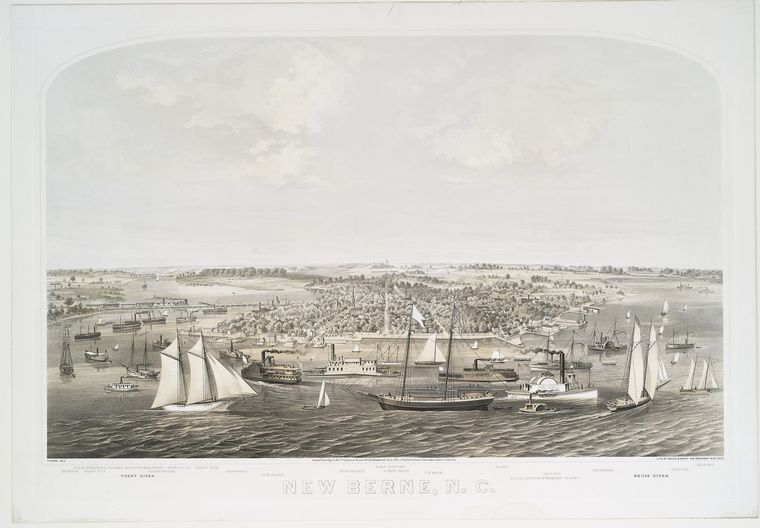
Start Date: February 1, 1864
End Date: February 2, 1864
New Bern, North Carolina, strategically sited on the Neuse River in North Carolina, had been captured by Union forces in March 1862. Not until January 1864 was Confederate Army of Northern Virginia commander General Robert E. Lee in position to propose a plan, which was duly approved by President Jefferson Davis, to retake New Bern, which was held by Union troops under Brigadier General Innis N. Palmer. For the operation, Lee detached 13,000 men under the command of Major General George E. Pickett. The men were on their way south on January 30, 1864.
The Confederate plan of attack, developed by Pickett’s subordinate, Brigadier General Robert F. Hoke, called for a coordinated attack with the Confederates converging on New Bern from three different directions. Brigadier General Seth M. Barton would move south of the Trent River and advance on New Bern from the southwest with most of 3 infantry brigades, 600 cavalry, and 14 artillery pieces. At the same time, Colonel James Dearing would strike from the northeast with 3 infantry regiments, 300 cavalry, and 3 guns to attack Fort Anderson, directly across the Neuse from New Bern. The third column, under Hoke with Pickett accompanying it, would consist of Hoke’s own division. It would strike from the northwest via Batchelder’s Creek.
There was also a fourth, naval, column. Confederate Navy commander John Taylor Wood would lead a daring night attack on the Union side-wheeler steam gunboat Underwriter, anchored in the Neuse near New Bern, to prevent it from aiding Union forces ashore. Toward this end the Confederates shipped a dozen small cutters by rail from Petersburg, Virginia, to Kinston, North Carolina, where they were started downriver.
The Confederate attack began well. Hoke was able to cross Batchelder’s Creek and repulse Union attacks against him, while Barton captured Union outposts below the town. Meanwhile, the Confederate water attack achieved success. The 14 Confederate boats carrying 300 men in them were not discovered until about 2:00 a. m. on February 2, when they were only 100 yards from the Underwriter. The attackers quickly boarded and overpowered the Union crew. Acting Master Jacob Westervelt, the Underwriter’s captain, was among those killed in the fight. Because the Union gunboat did not have steam up, Wood was thus unable to move it and soon found himself under heavy fire from Union shore batteries. Wood then ordered the ship scuttled.
At this point, however, the Confederate plans fell apart. Both Barton and Dearing found the Union defensive works too strong and failed to attack. With two of his three land prongs now stalled, Pickett withdrew Hoke’s division, marking the end of the battle. Sinking the Underwriter was the sole Confederate accomplishment of the battle. Casualties were light on both sides. Pickett estimated Union losses at about 100 men and Confederate casualties at half that figure. Pickett bears major responsibility for the failure of the attack, for the desired coordination did not materialize. Pickett then returned to Virginia. Hoke continued in command, and he then moved against Plymouth, North Carolina.
The Capture of Plymouth, North Carolina
May 5, 1864
In April 1864 the new shallow-draft Confederate ironclad ram Albemarle (with two 6.4-inch rifled guns) played the key role in the capture of Plymouth, North Carolina. The attack on the Union base, begun on April 17 by 7,000 Confederate troops under Brigadier General Robert F. Hoke, had failed in large part thanks to gunfire support provided by Union gunboats on the Roanoke River. Early on April 19, however, the Albemarle, captained by Commander James W. Cooke, appeared and attacked the Union wooden gunboats Miami (with one 6.4-inch Parrott rifled gun, six IX-inch smoothbore Dahlgrens, and one 24-pounder boat howitzer) and Southfield (with one 6.4-inch Parrott rifle and five IX-inch Dahlgrens). With Union shot bouncing harmlessly off its plated sides, the Albemarle rammed and sank the Southfield. The commander of the Southfield, Lieutenant Commander Charles W. Flusser, was killed; 11 other Union seamen were wounded, and 8 were taken prisoner. The Albemarle lost 1 man, killed by a pistol shot. The Miami and other Union ships then withdrew from the river to watch the ram from a distance. The Albemarle now controlled the water approaches to Plymouth. Its guns and the sharpshooters aboard the Confederate steamer Cotton Plant enabled the more numerous Confederate infantry to take Plymouth on April 20.